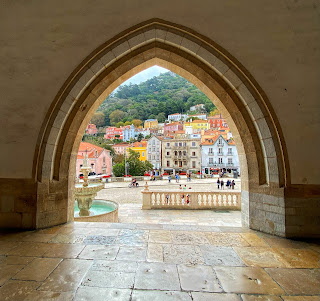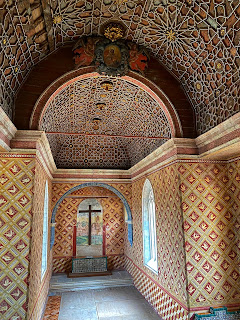 |
A Happy Solo in Sintra, Portugal
The drive through the
Portuguese Riviera from Cascais to Sintra took us just a few minutes. But we
travelled back in time by several centuries when we set foot on this
picturesque town that Lord Byron described as “glorious Eden” in his poem “Childe
Harold’s Pilgrimage”.
Like Lord Byron, my
eyes were first drawn to the mountain of Sintra, to the romantic ramparts of a
castle at its peak and the fairy tale-like village nestled at its feet.
 |
“And Cintra’s mountain greets them on their way” – Lord Byron |
The old world charm of Vila de Sintra immediately captivated me. As we crossed the street of the old town, I got a glimpse of its 19th century Romanticist architecture that earned for its Cultural Landscape a UNESCO World Heritage Site distinction.
 |
Pastel-painted buildings of Vila de Sintra framed by
the arcade of Sintra National Palace |
Palácio Nacional de Sintra
Our first stop was the
Sintra National Palace. The exterior was not as grandiose as one
would expect a palace to be. But I had read up on it and was excited to see the
inside of the best-preserved medieval royal residence in Portugal. The royals
have resided here continuously from about the 15th to the late 19th
century.
I’ve always been
interested in ancient history and a tour of the Sintra National Palace fascinated
me. Walk with me through its historic halls.
In my previous blog, I
mentioned the azulejos, the tiles that Lisbon and apparently the rest of
Portugal adorn many of their buildings with. Azulejaria, the art of
ceramic tilework, has transformed Portuguese buildings into stunning creations.
At the Sintra National Palace, many rooms were decorated with azulejos. There
was even a display of various tiles which I assumed were the ones used in the buildings.
The palace is reputed to have one of the most important collections of Baroque
tiles in Portugal and in the world.
It's interesting to
know that there are tiles exclusively made for the palace. The design on the azulejos
pictured below in the Sala Manuelina (Manueline Room) is the armillary
sphere of King Manuel I which was
commissioned by the king himself.
The Manueline Room was
the starting point of our palace tour. It served as the Great Hall in the time
of Manuel I. Its glimmering chandelier that bade us welcome was a sight to
behold.
The largest room in the
palace where official banquets are still held especially for visiting
dignitaries is the Sala dos Cisnes (Swan Room). This regal room
is aptly named after the stately swans that adorn its ceiling.
The Sala das Pegas (Magpie Room) has a funny story, true or not, with a couple of versions attached to it. One is that King João I was rumored to have been caught kissing a lady-in-waiting. He supposedly had the room decorated with chattering magpies as a dig towards rumor-mongering ladies of the court. Mag, a nickname for Margaret means “idle chattering” in English slang. Mag would be the English equivalent of our local Marites (in colloquial Filipino, a woman updated on the latest gossip).
 |
The Câmara do Ouro (Golden Chamber) also known as King Sebastião’s Room is where the king received nobility. It used to be resplendent with gold finish, but the decorations were lost over time. It still displays the State Bed made of chestnut and ebony, silvered brass and glass.
Annexed to this room
are two smaller ones:
The Guarda-Roupa
(Wardrobe), also called Mermaid’s Room because of its ceiling decoration. This
is where the king and queen’s clothes, jewelry, silver and other ceremonial
items are kept.
The Camarim
(Dressing Room) is where valuable objects are stored like this Celestial Globe made
of gilded metal and iron with constellations and signs of the zodiac. It’s the
only known 16th century globe of this type and the oldest in Portugal.
We then passed through
the Sala das Galés (Galleys Room) named for the Portuguese,
Imperial Ottoman and Dutch galleys painted on its ceiling.
The Sala dos
Brasões (Coat of Arms Room) is the most spectacular of all the rooms. King
Manuel I’s coat of arms at the center of the cupola lords it over the crests of
72 Portuguese noble families. Blue and white Baroque azulejos depicting
scenes of gallantry cover the walls of this magnificent heraldic room.
The room that I found
most intricately designed was the Capela (Royal Chapel), the
oldest surviving part of the palace. The Mudejar-style
ceiling, one of the oldest of its kind in existence, mimics a star-strewn sky
with its “tracery” radial and star-shaped motif. The doves representing the
Holy Spirit on the wall fresco added an air of serenity to the chapel.
Fountains seem to be a
favorite fixture in the palace. I saw them in the Entrance Hall, the courtyard,
the patios and one room, the Sala dos Árabes (Arab Room) even had
an ornate Moorish-style fountain as its centerpiece.
I found it curious that
the iconic feature of this palace is not a tower nor a dome but a pair of gigantic
conical chimneys.
As for us, we had no
time to chill. We were off to lunch and another trek through history among the
ruins of a castle.
Castelo
dos Mouros
The Castle of the Moors
is the one with the ramparts on the peak of Serra de Sintra that first attracted
my gaze. This medieval castle was
erected by the Moors from the 8th to the 9th century to defend the region. The territory was reclaimed by the Portuguese during the Reconquista. It is classified
as a National Monument, part of the Sintra Cultural Landscape as a zone of
special interest, and a UNESCO World Heritage Site.
We were brought to the
site by a smaller bus. Our tourist bus wouldn’t be able to navigate the narrow
twisting road. There’s another way up for the energetic and able-bodied – the hiking
trail. That was definitely not for us. The hilly terrain within the castle
grounds was already daunting for many in our group. But exploring the ancient
ruins was not something I will pass up on. I’m glad I braved the trek because I
not only got to walk amongst the spirits of Crusaders and Moors but was also
treated to the spectacular view this high vantage point offered.
I relished the
diversity of our tours in Sintra organized by WeFly MNL. In the morning, we travelled back in time
through the opulence of a palace. In the afternoon, we meandered over castle
ruins reclaimed from its conquerors by nature. After a briefing by our tour
guide, we were left to enjoy a tranquil hike into history.
Some highlights of the
castle:
Igreja
de São Pedro de Canaferrim (Church of St. Peter of
Canaferrim) is the first parish church of Sitra dating back to the 12th
century.
Torre
Real (Royal Tower). The 220 steep steps to its top promised
to show the most spectacular view of the hills and palaces surrounding the
castle. It is said that on a clear day you can also see neighboring towns. My roommate
Leni and I assumed the walk up would leave us gasping for breath.
So we contented ourselves
with a climb up to the battlements of the Muralha (Castle Walls),
the inner walls. The view was still stunning from where we stood.
The Alcáçova (Castle Keep) is the castle stronghold. This is where the Moorish lords reigned in times of peace and their last line of defense in times of war.
The view of Sintra National Palace from the battlements brought our day to full circle.
One of my favorite Castelo dos Mouros photos is the one I took of a flower that displayed gracefulness despite being on the verge of withering. I thought it represented Sintra so well – beauty in the midst of antiquity and ruin. I just had to capture it not only with my lens but also on paper. I dubbed my watercolor “Flor Antiga de Sintra” (“Ancient Bloom of Sintra”).





















